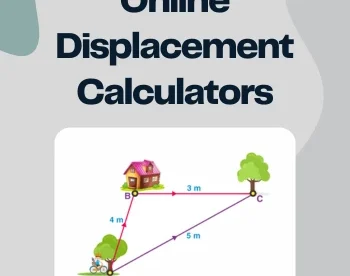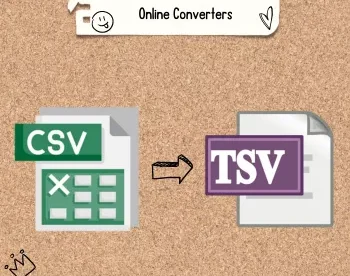5 Best Free Online NAND Calculator Websites
Here is a list of the best free online NAND Calculator websites. You might have heard about logic gates in electronics. NAND gates are logic gates that produce a true output only when both inputs are false. These gates can be combined to create other types of logic gates and circuits. A NAND calculator is a digital calculator that performs calculations using the NAND (NOT-AND) logic gate. Unlike a regular calculator, a NAND calculator uses NAND gates as the fundamental building blocks for performing arithmetic and logic operations.
This post covers 5 websites with NAND calculators. These NAND calculators allow you to calculate the NAND results of 2 or more inputs. Typically, NAND calculators work with Binary numbers. All these calculators support Binary numbers and most of them work with other data types as well. You can simply add your values and get the NANDed result of that. The comparison table below gives an insight into each calculator. You can check which calculator supports which data types. From the table, you can jump to any calculator to check it out in detail.
My Favorite Online NAND Calculator
ToolSlick.com is my favorite website on this list to calculate NAND operation online. This NAND Calculator works with Binary, Octal, Decimal, Hex, and ASCII values. It automatically detects the input type and provides the Binary, Octal, Decimal, Hex, and ASCII results for the added values.
You can check out our other lists of the best free online LM317 Calculator Websites, Logic Gate Simulator Software For Windows, and Truth Table Calculator Software For Windows.
Overview Table:
| Name | Input | Input Detection | Output |
|---|---|---|---|
| ToolSlick.com | Binary, Octal, Decimal, Hex, ASCII | Auto-detection/Manual | Binary, Octal, Decimal, Hex, ASCII |
| CodersTool.com | Binary, Decimal, Hex | Manual Selection | Binary, Octal, Decimal, Hex |
| CodeBeautify.org | Binary, Decimal, Hex | Auto-detection/Manual | Same as input |
| OnlineBinaryTools.com | Binary | - | Binary |
| FancyTextConverter.com | Binary, Decimal, Hex | Auto-detection/Manual | Same as input |
ToolSlick.com
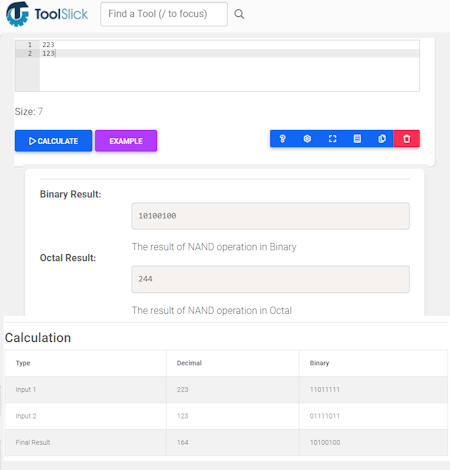
ToolSlick.com is a website that provides a variety of online productivity tools for programmers, data scientists, and internet users. It has a free online NAND calculator for bitwise NAND operation on text in ASCII or numbers in Binary, Octal, Decimal, and Hex formats. The calculator has a single input box for the input. You can simply add your two or more inputs into the box. The calculator can automatically detect the input type and perform the calculation. In the case of bulk data, you can add that directly with the delimiter of choice and go ahead with the calculation. It gives you the Binary result, Octal result, Decimal result, Hex result, and ASCII result.
How to calculate NAND online on ToolSlick?
- Go to this NAND calculator using the link provided below.
- Add your input into the box there and select the Input Base.
- After that, click the CALCULATE button to get the results.
Highlights:
- Supported Input: Binary, Octal, Decimal, Hex, and ASCII.
- Input Base Selection: Auto-detection as well as user selection.
- Results in: Binary, Octal, Decimal, Hex, and ASCII.
CodersTool.com
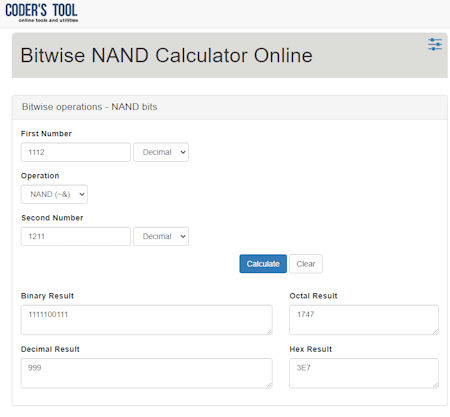
CodersTool.com is a website that provides free online tools for software developers and non-programmers. The website offers a wide variety of components for encoding, decoding, encryption, conversions, validation, layout, data generation, date functions, and more. This calculator supports Binary, Decimal, and Hex inputs. It is limited to two inputs and lets you select the input type for those individually. With that, you can perform the NAND operation on the added numbers and get the output. The calculator shows the Binary, Octal, Decimal, and Hex results.
How to calculate NAND online on CodersTool?
- Follow the link given below to open this NAND Calculator tool.
- Enter the first and second numbers by selecting the bits type.
- Then select the NAND operator for the calculation.
- Then click the Calculate button to get the result.
Highlights:
- Supported Input: Binary, Decimal, and Hex.
- Input Base Selection: User selection.
- Results in: Binary, Decimal, and Hex.
CodeBeautify.org
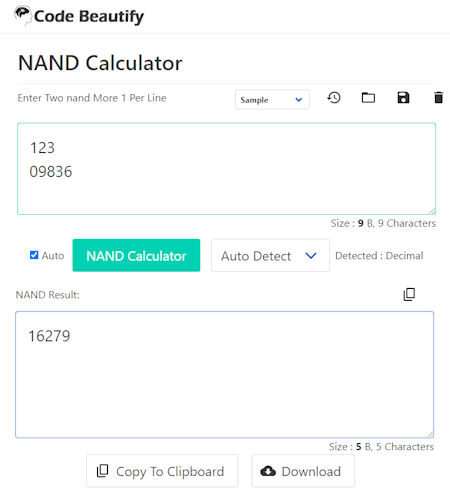
CodeBeautify.org is an online platform that offers code beautification and formatting tools. It features an online NAND calculator that supports Binary, Decimal, and Hex inputs. The calculator has two text boxes for input and output. It can calculate NAND operation for 2 or more inputs. To perform the calculation, you have to add 1 input per line. The calculator can auto-detect the input type and perform the calculation. Alternatively, you also get an option to define the input type manually. With that, you get the output in the same data type as the input.
How to calculate NAND online on CodeBeautify?
- Head over to this NAND Calculator on CodeBeautify using the link given below.
- Add your input numbers in the box there. Separate multiple inputs into new lines.
- Then click the NAND Calculator button to get the output.
Highlights:
- Supported Input: Binary, Decimal, and Hex.
- Input Base Selection: Auto-detection and user selection.
- Results in: Binary, Decimal, and Hex.
OnlineBinaryTools.com
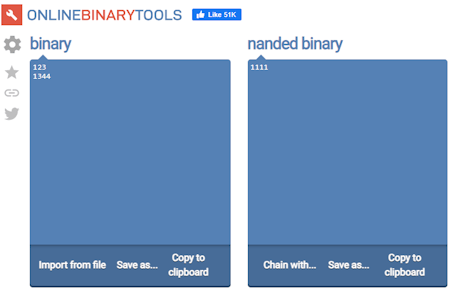
OnlineBinaryTools.com offers a collection of simple, free, and easy-to-use binary utilities for working with binary values. The website features a Binary NAND calculator where you can add your binary values and get NANDed together. The calculator works with Binary values only. You can add any number of values to perform the calculation. The calculator also supports file import that lets you add values from a file. As soon as you add the binary input, the calculator instantly gets you the NANDed binary output for that. From there, you can copy and save the output.
How to calculate NAND online on OnlineBinaryTools?
- Use the link given below to access this online NAND calculator directly.
- Add your Binary inputs in the binary section. You can also upload a file with the Binany data.
- When you add the input, the calculator shows the results in the adjacent NANDed binary section.
Highlights:
- Supported Input: Binary.
- Input Base Selection: N/A.
- Results in: Binary.
FancyTextConverter.com
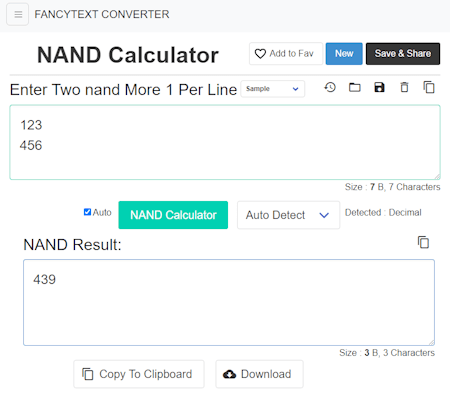
FancyTextConverter.com is another free website with an online NAND calculator. This website uses a port of BeautifiyTool’s NAND Calculator. The calculator inherits the same features and interface. It supports Binary, Decimal, and Hex input. It can work with 2 or more inputs that you have to add in the input box. Make sure you add 1 value per line. The calculator can automatically detect input type with an option for a manual section. You can simply add your input and perform the calculation. This gets you the NAND result in the box below. This calculator gives you the result in the same data type as input. You get a copy button to copy the result. Apart from that, you can also download the output as a TXT file.
How to calculate NAND online on FancyTextConverter?
- Use the direct link given below to access this calculator.
- Enter your input in the box and keep 1-value per line.
- After that, click the NAND Calculator button to get the result.
Highlights:
- Supported Input: Binary, Decimal, and Hex.
- Input Base Selection: Auto-detection and user selection.
- Results in: Binary, Decimal, and Hex.
Frequently Asked Questions
A NAND calculator is a digital calculator that performs calculations using the NAND (NOT-AND) logic gate.
NAND gates are logic gates that produce a true output only when both inputs are false. They can be combined to create other types of logic gates and circuits.
In terems of online calculators, you can simply paste or enter the inputs.
Typically, numbers are entered in binary format, with each digit represented by a 0 or 1.
Yes, NAND calculators allow you to perform bitwise AND, OR, and XOR operations.
NAND gates are universal gates, meaning they can be used to construct any other type of logic gate. This makes them versatile for building complex circuits.
Some NAND calculators may have programmable features, allowing users to create custom logic circuits.
While NAND calculators are not designed for programming, they can help understand the underlying logic principles used in computing.
About Us
We are the team behind some of the most popular tech blogs, like: I LoveFree Software and Windows 8 Freeware.
More About UsArchives
- May 2024
- April 2024
- March 2024
- February 2024
- January 2024
- December 2023
- November 2023
- October 2023
- September 2023
- August 2023
- July 2023
- June 2023
- May 2023
- April 2023
- March 2023
- February 2023
- January 2023
- December 2022
- November 2022
- October 2022
- September 2022
- August 2022
- July 2022
- June 2022
- May 2022
- April 2022
- March 2022
- February 2022
- January 2022
- December 2021
- November 2021
- October 2021
- September 2021
- August 2021
- July 2021
- June 2021
- May 2021
- April 2021
- March 2021
- February 2021
- January 2021
- December 2020
- November 2020
- October 2020
- September 2020
- August 2020
- July 2020
- June 2020
- May 2020
- April 2020
- March 2020
- February 2020
- January 2020
- December 2019
- November 2019
- October 2019
- September 2019
- August 2019
- July 2019
- June 2019
- May 2019
- April 2019
- March 2019
- February 2019
- January 2019
- December 2018
- November 2018
- October 2018
- September 2018
- August 2018
- July 2018
- June 2018
- May 2018
- April 2018
- March 2018
- February 2018
- January 2018
- December 2017
- November 2017
- October 2017
- September 2017
- August 2017
- July 2017
- June 2017
- May 2017
- April 2017
- March 2017
- February 2017
- January 2017
- December 2016
- November 2016
- October 2016
- September 2016
- August 2016
- July 2016
- June 2016
- May 2016
- April 2016
- March 2016
- February 2016
- January 2016
- December 2015
- November 2015
- October 2015
- September 2015
- August 2015
- July 2015
- June 2015
- May 2015
- April 2015
- March 2015
- February 2015
- January 2015
- December 2014
- November 2014
- October 2014
- September 2014
- August 2014
- July 2014
- June 2014
- May 2014
- April 2014
- March 2014

